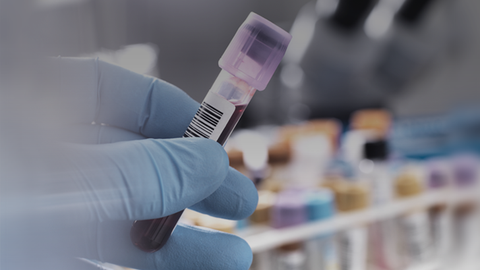When treating patients with metastatic breast cancer, it’s important to repeatedly conduct liquid biopsies to look for acquired ESR1 mutations when patients progress after endocrine therapy, even if initial testing was done. That’s why Dr. Charles Turck is breaking down best practices for utilizing liquid biopsies to detect ESR1 mutations with Drs. Stephanie Graff and Pavani Chalasani. Dr. Graff is the Director of Breast Oncology at the Lifespan Cancer Institute in Providence, Rhode Island, and Dr. Chalasani is the Division Director of Hematology-Oncology at the GW Cancer Center in Washington, DC.
ReachMD
Be part of the knowledge.™We’re glad to see you’re enjoying ReachMD…
but how about a more personalized experience?
Best Practices for Detecting ESR1 Mutations in Metastatic Breast Cancer

Announcer Introduction
You’re listening to Project Oncology on ReachMD, and this episode is sponsored by Stemline, a Menarini Group company. Here’s your host, Dr. Charles Turck.
Dr. Turck:
This is Project Oncology on ReachMD, and I’m Dr. Charles Turck. Joining me to share best practices for utilizing serial blood testing to look for acquired ESR1 mutations in patients with metastatic breast cancer are Drs. Stephanie Graff and Pavani Chalasani. Dr. Graff is the Director of Breast Oncology at the Lifespan Cancer Institute in Providence, Rhode Island. Dr. Graff, thanks for being here today.
Dr. Graff:
Thanks for inviting me.
Dr. Turck:
And not only is Dr. Pavani Chalasani a fellow ReachMD host, but she is also the Division Director at the GW Cancer Center in Washington, DC. Dr. Chalasani, it’s great to have you with us as well.
Dr. Chalasani:
Thank you for having me.
Dr. Turck:
So let’s just dive right in, starting with you, Dr. Graff. How and when should we test for ESR1 mutations in our patients with metastatic breast cancer?
Great question. So I think that we should be testing for ESR1 mutations often. But ESR1 mutations are mutations that are mechanisms of resistance, so patients need to have progressed on endocrine therapy prior to testing patients for ESR1 mutations. Theoretically, you could include patients who were on endocrine therapy adjuvantly and who present with metastatic disease on adjuvant therapy and test them. That wasn't the population that was included in the EMERALD trial, but those patients could already have ESR1 mutations.
The EMERALD trial, which is of course really what brought this into play and why we're discussing it today, included patients who were farther out from their diagnosis and presenting after progression on either an aromatase inhibitor alone or fulvestrant alone or in combination with the CDK4/6 inhibitor and tested them at the time of progression. Of course, ESR1 mutations in the EMERALD trial were done on serum, which I think in clinical practice is the absolute best scenario. You don't have to send somebody for a bone biopsy or liver biopsy; you could just draw a blood specimen, and test for ESR1 that way. And so for me, I am testing patients after progression on first-line therapy for metastatic disease to check for ESR1 at that time. If the mutation’s present, it's an indication for consideration of elacestrant. Hopefully other ESR1 targeting agents are soon to follow.
And then I think the other time to test is after other lines of therapy, particularly in the hormone setting. So although, again, most of the patients on EMERALD trial were after that first-line therapy, there's nothing to say that somebody can't develop an ESR1 mutation after second-line fulvestrant, second-line PIK3CA targeting, or second-line AI plus mTOR. So if you're still using hormonal manipulation in your treatment paradigm, you can still develop hormonal resistance using ESR1, and you should keep considering retesting for those patients.
Dr. Turck:
Turning to you now, Dr. Chalasani, what are the preferred samples to use when testing for ESR1 mutations?
Dr. Chalasani:
So in clinic and for practical use, we have both liquid and tumor samples we could send out for next-gen sequencing to look for ESR1 mutations. If you're looking for ESR1 mutations alone for a treatment decision, liquid biopsy or serum samples or blood samples when the patient is in clinic are very practical and reliable validated sources for sequencing and to detect the mutations.
The EMERALD trial has demonstrated that serum samples can be used, and various other trials and data which has been published has shown that liquid biopsy is a very reliable and validated sample. We can also send for tumor sequencing testing, but it comes with its challenges where if there is tumor heterogeneity, what sample we are sending out with sequencing? There is a challenge with tumor testing in addition if having to put the patients through an additional biopsy for the most recent sample which has seen or been exposed to treatment.
Now on the flip side for the liquid biopsy, the challenge is if there are genetic alterations which exist in very low concentrations in the tumor, they may not be able to be detected.
So both sequencing liquid or tumor have their own challenges, but for ESR1 mutations alone, doing liquid biopsy can be done in a fast, reliable, and a patient-friendly manner in clinic for clinical utility.
Dr. Turck:
And as a quick follow-up to that, Dr. Chalasani, how do we interpret the results from a liquid biopsy?
Dr. Chalasani:
The liquid biopsies are typically looking for very point mutations. So it's looking for circulating tumor DNA which has been spilled. So that was one of the skepticisms in the beginning. And also, one other concern is we may not be able to pick up all the genetic alterations if they are especially present in low concentration in a tumor or they're not spilled enough into the blood sample when we process. However, I think ESR1 and some other tumor genetic alterations have been shown consistently to be able to be detected in the liquid biopsy. So the reports, depending on various companies which offer the liquid biopsies, they report as a percentage of the tumor mutation burden that we see. Some genetic alterations are reported as variant allele frequencies, some as percentage mutations, but those are the ones we look for when the report is generated.
Dr. Turck:
For those just tuning in, you’re listening to Project Oncology on ReachMD. I’m Dr. Charles Turck, and I’m speaking with Drs. Stephanie Graff and Pavani Chalasani about the role of liquid biopsies in testing for acquired ESR1 mutations in metastatic breast cancer.
Coming back to you, Dr. Graff, how can we adjust treatment when a liquid biopsy identifies endocrine therapy resistance in a patient?
Dr. Graff:
Yeah, so I think that at this point in time, the only therapy that we have that's approved for patients with ESR1 mutations detected is elacestrant. And so once you detect an ESR1 mutation, changing their endocrine therapy to elacestrant is the current standard of care. We do see an improvement in outcome with elacestrant, and I think that that improvement in outcome is really important. It is an oral therapy; it had not only an improvement in outcome, but was well tolerated on clinical trial. And I think that the longer we can maintain our patients on oral therapy with a good quality of life, the more we should be offering that to patients. I think elacestrant is a clear standard-of-care option for patients that develop ESR1 mutations.
What I anticipate over time as the story of ESR1 and SERDs continues to develop in the landscape of breast oncology is that other SERDs will emerge that also are likely to have potency against ESR1 mutations, and we also are likely to gather data on those SERDs in combination with other drugs, including possibly the AKT inhibitor capivasertib and with CDK4/6 inhibitors. And especially if we end up seeing that post-MONARCH confirms the MAINTAIN trial for extending CDK4/6 inhibitors, we may consider doing things like when an ESR1 mutation develops, changing the endocrine therapy backbone and continuing that CDK4/6 inhibitor for those patients. But for now, while we wait for that data to emerge or develop, when you find an ESR1 mutation, changing to elacestrant is our current best option.
Dr. Turck:
Now given everything we’ve discussed today, I’d like to hear from each of you before we close on how we can better integrate liquid biopsies into clinical practice. Dr. Graff, let’s hear from you first.
Dr. Graff:
I think the best way to integrate liquid biopsies into clinical practice is to do them early and remember that they exist for our patients. So again, when I say early, I mean on first progression after CDK4/6 inhibitors for metastatic hormone receptor-positive breast cancer, certainly prior to going to systemic chemotherapy; that's where we're going to see the biggest benefit for therapies like elacestrant. But also we can do them repeatedly, so if you test a patient, they're negative for an ESR1 mutation and you go ahead and start them on something like fulvestrant, for example, and then they progress on fulvestrant, you can still retest for ESR1. And if they've developed an ESR1 mutation in that intervening time, then you now have a patient who is at that time eligible for elacestrant. So you can continue to screen patients on therapy for possibility of adding something that will target the ESR1 mutation.
Dr. Turck:
Thanks, Dr. Graff. And Dr. Chalasani, do you have any other tips on its integration or other final thoughts?
Dr. Chalasani:
So in addition to what Dr. Graff has just mentioned, the utility of ESR1 mutations or frequency of mutations or change in therapy has been demonstrated beautifully in a trial presented at San Antonio, which was called the PADA-1 trial. The study investigators enrolled patients with metastatic breast cancer who were started on aromatase inhibitors and CDK4/6 inhibitors. They were serially testing for ESR1 mutations, and upon detection of ESR1 mutations, the patients did undergo staging, and if there was no disease progression, they were either randomized to fulvestrant with CDK4/6 inhibitors or continuing on aromatase inhibitors and CDK4/6 inhibitors. Early switch to a fulvestrant and CDK4/6 inhibitors, that group of patients actually did demonstrate an improved progression-free survival. But again, it's a proof of principle showing that early switching on detection of this by changing the endocrine therapy backbone to improve outcomes for patients has been demonstrated very well. It also supports the clinical utility and testing.
One of the things we have to recognize is in the PADA-1 trial, they switched to fulvestrant and CDK4/6 inhibitors. We currently do not have data for elacestrant or other oral SERDs in combination with CDK4/6 inhibitors or other targeted therapies. We are anxiously waiting for that data, and we are hopeful that they will come out soon, demonstrating safety so we could use that in clinical practice.
Dr. Turck:
Well with those final comments in mind, I want to thank my guests, Drs. Stephanie Graff and Pavani Chalasani, for joining me to discuss the importance of testing for ESR1 mutations in patients with metastatic breast cancer. Dr. Graff, Dr. Chalasani, it was great having you both on the program.
Dr. Graff:
Thank you.
Dr. Chalasani:
Thank you for having me.
Announcer Close
This episode of Project Oncology was sponsored by Stemline, a Menarini Group company. To access this and other episodes in our series, visit Project Oncology on ReachMD.com, where you can Be Part of the Knowledge. Thanks for listening!
Related
- video
How Testing for Acquired vs. Intrinsic Mutations in HR+/HER2- Metastatic Breast Cancer Differs
Show more - video
What to Know About ESR1 Mutations in HR+/HER2- Metastatic Breast Cancer
Show more - video
ESR1 Mutations in Metastatic Breast Cancer: A Predictor of Poor Prognosis
Show more - video
Detecting ESR1 Mutations in Metastatic Breast Cancer: The Role of Liquid Biopsies
Show more
Recommended
Sponsored by
Overview
When treating patients with metastatic breast cancer, it’s important to repeatedly conduct liquid biopsies to look for acquired ESR1 mutations when patients progress after endocrine therapy, even if initial testing was done. That’s why Dr. Charles Turck is breaking down best practices for utilizing liquid biopsies to detect ESR1 mutations with Drs. Stephanie Graff and Pavani Chalasani. Dr. Graff is the Director of Breast Oncology at the Lifespan Cancer Institute in Providence, Rhode Island, and Dr. Chalasani is the Division Director of Hematology-Oncology at the GW Cancer Center in Washington, DC.
Related
- video
How Testing for Acquired vs. Intrinsic Mutations in HR+/HER2- Metastatic Breast Cancer Differs
Show more - video
What to Know About ESR1 Mutations in HR+/HER2- Metastatic Breast Cancer
Show more - video
ESR1 Mutations in Metastatic Breast Cancer: A Predictor of Poor Prognosis
Show more - video
Detecting ESR1 Mutations in Metastatic Breast Cancer: The Role of Liquid Biopsies
Show more









Facebook Comments